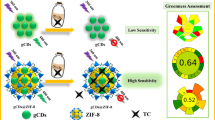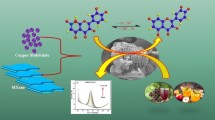Abstract
An electrochemical analysis using a multi-walled carbon nanotube (MWCNT) electrode is applied to examine chlorogenic acids (3-cafeoylquinic (3CQ), 4-cafeoylquinic (4CQ), 5-cafeoylquinic (5CQ), 3,4-dicafeoylquinic (34dCQ), 3,5-dicafeoylquinic (35dCQ), 4,5-dicafeoylquinic (45dCQ), 3-feruloylquinic (3FQ), 4-feruloylquinic (4FQ), and 5-feruloylquinic (5FQ) acid), which are the main ingredients of coffee polyphenols. The MWCNT electrode shows an excellent performance in the electrochemical quantification of chlorogenic acids. Cyclic voltammetry (CV) of all the chlorogenic acids shows redox peak pairs ranging between + 0.27 and + 0.31 V that are assigned to the redox reaction of the catechol group. Changes in the current due to individual chlorogenic acids at the peak potentials are proportional to their concentrations (3CQ, 4CQ, and 5CQ: linear range 0.4–194 μM, sensitivity 1.8 μA μM−1 cm−2; 34dCQ, 35dCQ, and 45dCQ: linear range 9.5–194 μM, sensitivity 4.3 μA μM−1 cm−2; and 3FQ, 4FQ, and 5FQ: linear range 5–194 μM, sensitivity 0.094 μA μM−1 cm−2). High-performance liquid chromatography (HPLC) analysis of coffee infusions shows that chlorogenic acids are almost entirely composed of 3CQ, 4CQ, and 5CQ. The total amounts of 3CQ, 4CQ, and 5CQ in coffee infusions obtained by HPLC show good agreement with those obtained by CV using the MWCNT electrode. This result indicates that the redox peak current can quantify the total amount of chlorogenic acid in a coffee infusion.







Similar content being viewed by others
References
Cano-Marquina A, Tarínb JJ, Canoc A (2013) The impact of coffee on health. Maturitas 75:7–21
Carvalho ML, Santhiago M, Peralta RA, Neves A, Micke GA, Vieira IC (2008) Determination of chlorogenic acid in coffee using a biomimetic sensor based on a new tetranuclear copper(II) complex. Talanta 77:394–399
Chen Y, Huang W, Chena K, Zhang T, Wang Y, Wang J (2019) A novel electrochemical sensor based on core-shell-structured metal-organic frameworks: the outstanding analytical performance towards chlorogenic acid. Talanta 196:85–91
Chokkareddy R, Bhajanthri NK, Redhi GG (2017a) A novel electrode architecture for monitoring rifampicin in various pharmaceuticals. Int J Electrochem Sci 12:9190–9203
Chokkareddy R, Bhajanthri NK, Redhi GG, Redhi DG (2017b) Ultra-sensitive electrochemical sensor for the determination of pyrazinamide. Curr Anal Chem 14:391–398
Chokkareddy R, Bhajanthri NK, Redhi GG (2018) An enzyme-induced novel biosensor for the sensitive electrochemical determination of isoniazid. Biosensors 7:21
Chokkareddy R, Redhi GG, Karthick T (2019) A lignin polymer nanocomposite based electrochemical sensor for the sensitive detection of chlorogenic acid in coffee samples. Heliyon 5:e01457
David IG, Popa DE, Buleandra M, Moldovan Z, Iorgulescu EE, Badea IA (2016) Cheap pencil graphite electrodes for rapid voltammetric determination of chlorogenic acid in dietary supplements. Anal Methods 8:6537–6544
Duarte GS, Pereira AA, Farah A (2010) Chlorogenic acids and other relevant compounds in Brazilian coffees processed by semi-dry and wet post-harvesting methods. Food Chem 118:851–855
Farah A, Paulis TD, Trugo LC, Martin PR (2005) Effect of roasting on the formation of chlorogenic acid lactones in coffee. J Agri Food Chem 53:1505–1513
Hu GL, Wang X, Zhanga L, Qiu MH (2019) The sources and mechanisms of bioactive ingredients in coffee. Food Funct 10:3113–3126
Karaosmanoglu H, Suthanthangjai W, Travas-Sejdic J, Kilmartin PA (2016) Electrochemical analysis of beverage phenolics using an electrode modified with poly(3,4-ethylenedioxithiophene). Electrochim Acta 201:366–373
Laviron E (1979) General The use of linear potential sweep voltammetry and of A.C. voltammetry for the study of the surface electrochemical reaction of strongly adsorbed systems and of redox modified electrodes. J Electroanal Chem 100:263–270
Ludwig IA, Clifford MN, Lean MEJ, Ashihara H, Crozier A (2014) Coffee: biochemistry and potential impact on health. Food Funct 5:1695–1717
Ma X, Yang H, Xiong H, Li X, Gao J, Gao Y (2016) Electrochemical behavior and determination of chlorogenic acid based on multi-walled carbon nanotubes modified screen-printed electrode. Sensors 16:1797
Meinhart AD, Caldeirão L, Damina FM, Filho JT, Godoy HT (2018) Analysis of chlorogenic acids isomers and caffeic acid in 89 herbal infusions (tea). J Food Comp Anal 73:76–82
Mills CE, Oruna-Concha MJ, Mottram DS, Gibson GR, Spencer JPE (2013) The effect of processing on chlorogenic acid content of commercially available coffee. Food Chem 141:3335–3340
Monteiro MC, Farah A (2012) Chlorogenic acids in Brazilian Coffea arabica cultivars from various consecutive crops. Food Chem 134:611–614
Muguruma H, Inoue Y, Inoue H, Ohsawa T (2016) Electrochemical study of dopamine at electrode fabricated by cellulose-assisted aqueous dispersion of long-length carbon nanotube. J Phys Chem C 120:12284–12292
Muguruma H, Murakami S, Takahashi S, Osakabe N, Inoue H, Ohsawa T (2019) Separationless and adsorptionless quantification of individual catechins in green tea with a carbon nanotube-carboxymethylcellulose electrode. J Agri Food Chem 67:943–954
Oliveira-Neto JR, Rezende SG, Reis CF, Benjamin SR, Rocha MDL, Gil ES (2016) Electrochemical behavior and determination of major phenolic antioxidants in selected coffee samples. Food Chem 190:506–512
Ribeiro CM, Miguel EM, Silva JS, Silva CB, Goulart MOF, Kubota LT, Gonzaga FB, Santos WJR, Lima PR (2016) Application of a nanostructured platform and imprinted sol-gel film for determination of chlorogenic acid in food samples. Talanta 157:119–125
Rodrigues NP, Bragagnolo N (2013) Identification and quantification of bioactive compounds in coffee brews by HPLC–DAD–MSn. J Food Comp Anal 32:105–115
Šeruga M, Tomac I (2014) Electrochemical behaviour of some chlorogenic acids and their characterization in coffee by square-wave voltammetry. Inter J Electrochem Sci 9:6134–6154
Tajik N, Tajik M, Mack I, Enck P (2017) The potential effects of chlorogenic acid, the main phenolic components in coffee, on health: a comprehensive review of the literature. Eur J Nutr 56:2215–2244
Takahashi S, Muguruma H, Osakabe N, Inoue H, Ohsawa T (2019) Electrochemical determination with a long-length carbon nanotube electrode of quercetin glucosides in onion, apple peel, and tartary buckwheat. Food Chem 300:125189
Tomac I, Šeruga M (2016) Electrochemical properties of chlorogenic acids and determination of their content in coffee using differential pulse voltammetry. Inter J Electrochem Sci 11:2854–2876
Tomac I, Šeruga M, Beinrohr E (2017) Characterization of chlorogenic acids in coffee by flow-through chronopotentiometry. Food Anal Methods 10:3924–3933
Yardım Y, Keskin E, Şentürk Z (2013) Voltammetric determination of mixtures of caffeine and chlorogenic acid in beverage samples using a boron-doped diamond electrode. Talanta 116:1010–1017
Zhang T, Chen Y, Huang W, Wang Y, Hu X (2018) A novel AuNPs-doped COFs composite as electrochemical probe for chlorogenic acid detection with enhanced sensitivity and stability. Sens. Actuators B 276:362–369
Ziyatdinova G, Aytuganova I, Nizamova A, Budnikov H (2013) Differential pulse voltammetric assay of coffee antioxidant capacity with MWNT-modified electrode. Food Anal Methods 6:1629–1638
Funding
This research was funded by Grant-in-Aide for Scientific Research C 19K05172 of Japan Society for the Promotion Science.
Author information
Authors and Affiliations
Corresponding author
Ethics declarations
Conflict of Interest
The authors declare that they have no conflict of interests.
Ethical Approval
This article does not contain any studies with human participants or animals performed by any of the authors.
Additional information
Publisher’s Note
Springer Nature remains neutral with regard to jurisdictional claims in published maps and institutional affiliations.
Rights and permissions
About this article
Cite this article
Takahashi, S., Wada, R., Muguruma, H. et al. Analysis of Chlorogenic Acids in Coffee with a Multi-walled Carbon Nanotube Electrode. Food Anal. Methods 13, 923–932 (2020). https://doi.org/10.1007/s12161-020-01714-6
Received:
Accepted:
Published:
Issue Date:
DOI: https://doi.org/10.1007/s12161-020-01714-6




